Chicory
a 'happy liver' weed
Blooming indigo blue all over weedom are the chicory weeds, Cichorium intybus. They popped into mind during a conversation about weeds have been used as food to keep the liver happy and in tune. Hepatoprotective would be the word for that. (Chicory has therefore supplanted prior plans to give a State of the weedom address after our sixth month of existence, but there is a significant announcement at the end of this post, for our loyal readers.)
Cichorium intybus has a long history in traditional herbal medicine, and current industrial interest as a functional food and source of numerous useful compounds. Experimental evidence supports the uses of chicory for antidiabetic and anti-tumor effects, and as an anti-inflammatory, antioxidant, immune modulating, hepato-protectant, anti-helmintic and prebiotic herb. It is observed to regulate appetite, promote good digestion, and decrease the risk of gastrointestinal diseases. Inulin and a host of other compounds contribute to these effects. At weedom, we see it as agricultural care of the gut microbiome, with many positive bodily effects springing forth from a happy intestinal tract. While a person is acclimating to the use of chicory as a functional food considerable, “dose dependent” flatulence is to be expected. High inulin containing roots such as chicory, dandelion, Jerusalem artichoke are famous for inducing a musical recital from the wind instruments of the GI tract. Starting with small amounts, and working one’s way upward is a way to prevent excessive gaseous emissions.
Chicory is parked in a place right between dandelion and wild lettuce, from a biochemical standpoint and with respect to appearance.
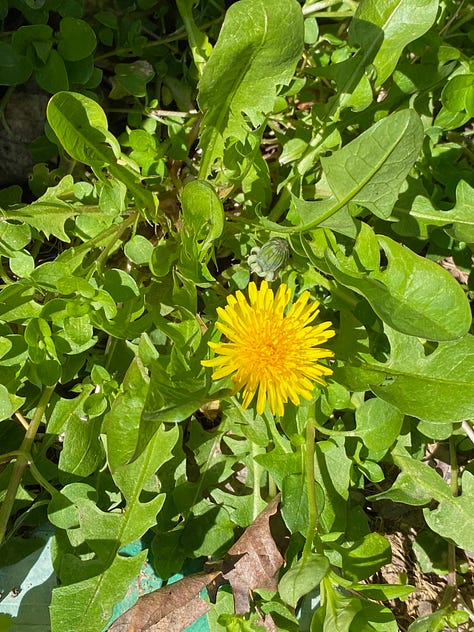
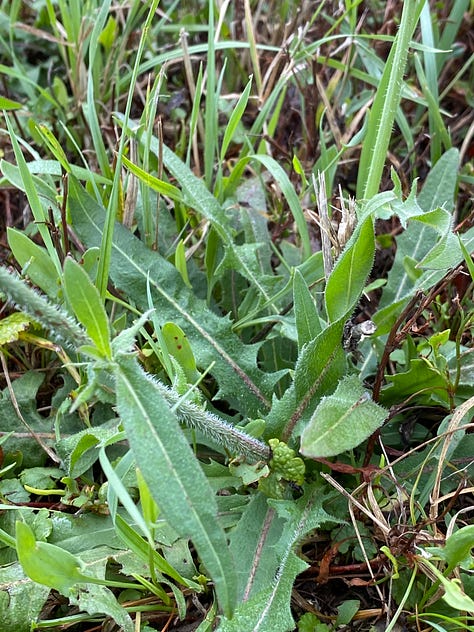
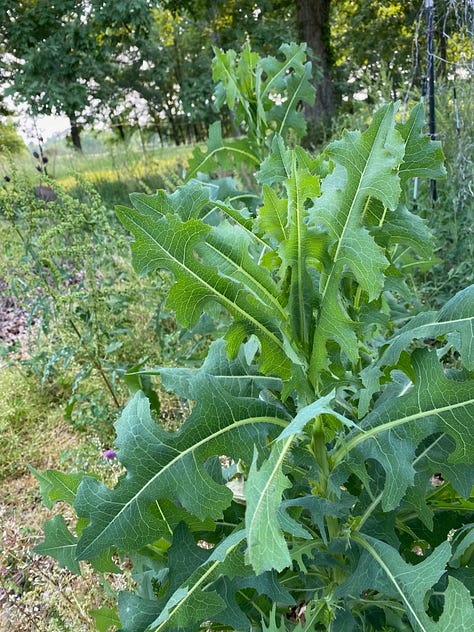
Keeping these three plants in mind will allow you to distinguish Chicory from the other two with ease, even when looking at the young plants, although rosettes of chicory and dandelion can be confusing. Fortunately those two are used similarly in the diet and in herbalism, so a mistake wouldn’t be disastrous, however there are some good reasons for you to know which root you’re digging up. The leaves of all 3 plants have similar shape, with irregular teeth and lobes. Wild lettuce, which forms leaves clasping an upright stem even when young, has spines along the underside midrib of the leaf. Chicory has a hairy midrib underneath the leaf, and the midrib of the dandelion leaf is entirely smooth. Knowing this will allow you to distinguish the young plants, before their other identifying features are apparent. It’s worthwhile for plant identification to go directly to our online site and click on the pics to see larger views. All three of these plants produce a milky white sap when their leaves or stems are broken.
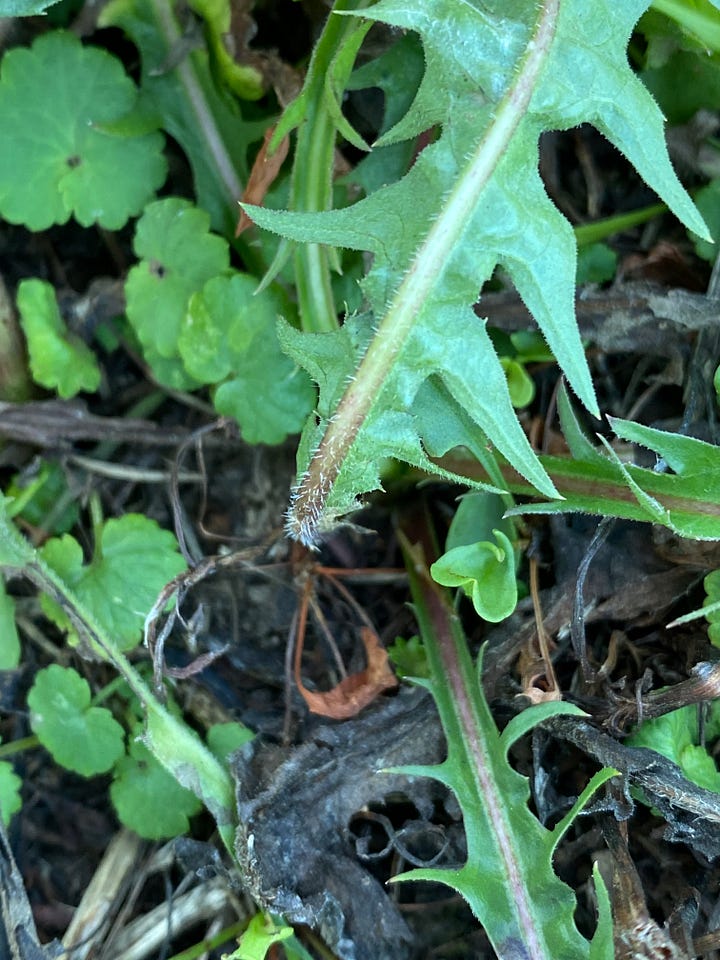
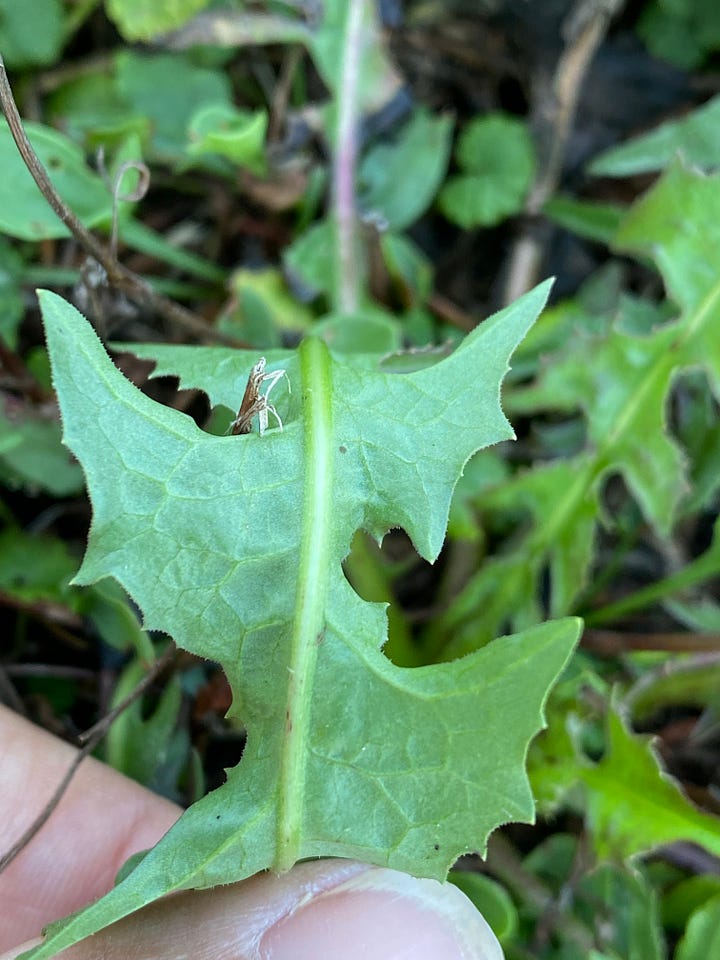
Another easy way to locate the chicory is to get outside in the morning and see all those blue flowers which close up after midday. Then remember where all chicory patches were, in the late summer and fall when you go after the roots. This weed loves roadsides and any disturbed areas of ground, and tolerates gravelly hard packed soil. It might be a significant issue finding these plants in pristine, unspoiled territory. At weedom, they’re growing profusely along a fence line where pine trees were recently cleared.
Occupying temperate zones from 3a to 8b, this member of the Asteraceae family prefers neutral soil pH from 6-8 and is fairly tolerant of dry conditions. It can be biennial or perennial, forming a rosette in the first year, and most often sending up a flowering stem in the second year. As seen above, the leaves of the rosette resemble those of dandelion, growing up to 8 inches long and up to 2 inches wide, with irregular teeth. Chicory leaves have variable hairs and a rougher feeling than dandelion leaves, with the most conspicuous hairs along the midrib on the underside of the leaf. The leaves of flowering stems emerge alternately, with the petiole becoming non existent on the smaller leaves which clasp the higher parts of the stem. Upper leaves are much less lobed and become lance like in appearance.
Stalkless flowers, 1 to 1.5 inches (2.5 -4 cm.) in diameter, have 7-20 petals, with serrations on their outer ends. They bloom in the morning, throughout the summer and may appear until frost. Flowers usually close at midday unless they are shaded or the weather is cloudy. Flowering stems are wiry or woody, and hairy, particularly towards the base. Breaking them produces a milky sap, like the related dandelion or wild lettuce. The flowers produce brown or tan achene type fruits with 5 ribs.
Chicory is related to the cultivated endives, such as Belgian endive, and curly endive, Cichorium endivia. Other varieties of chicory, such as Cichorium intybus, var. sativa, are grown commercially for production of inulin or other components. Roots of Cichorium intybus are often dried, roasted and used as a coffee substitute. In New Orleans, the tradition of adding chicory when brewing coffee continues, imparting a darker color and sweeter, nuttier taste.
Like dandelion, chicory contains a huge array of potentially medicinal and protective compounds. This short read will only scratch the surface, so expect future posts extolling the endless possibilities of this weed.
Some studies in rats indicated that whole plant extracts of chicory could inhibit maximal electroshock induced seizures, similarly to diazepam, and partially inhibit pentalenetetrazole induced seizures, but not strychnine induced seizures. The different models teased out possible mechanisms of action, and pointed towards effects on GABA and glutamate mediated, but not glycine mediated neurotransmission.
The traditional, human use of chicory decoctions for anti-diabetic effect has induced a search for the active constituents. An extract of chicory root containing predominantly chicoric acid and chlorogenic acid was observed in streptozocin induced diabetic rats to increase insulin sensitivity and glucose tolerance after six days of treatment. Other constituents of the extract possibly enhanced this effect.
Our weed of the week produces a number of anti-inflammatory, analgesic, and somewhat sedating, sesquiterpine lactone compounds in common with wild lettuce, Lactuca virosa. The compounds lactucin, lactucopicrin and 11β,13-dihydrolactucin, present in both weeds, showed analgesic activity comparable to ibuprofen in a hot plate test of mice, and seemed more potent than ibuprofen in a tail flick test. Lactucin and lactucopicrin also showed sedating activity in a spontaneous locomotor test. If you’ve been wondering why people have gotten a sudden interest in wild lettuce, now you know. But you can keep all the chicory for yourself :-D
Moving to the liver protection offered by this herb, we can reasonably assume that part of this benefit derives from a happy, healthy gut, allowing fewer toxins into the bloodstream, giving the liver less work to do.
Extracts of chicory have shown hepatoprotective effects in numerous types of liver injury in various human and animal subjects. Alcoholic, methanolic and water extracts of root, leaves, seeds and fruits have shown some aspects of this activity. Analysis of 5 human studies with a total of 197 patients with non alcoholic fatty liver disease showed significant decreases in aspartate transaminase (AST) and alanine transaminase (ALT) with use of chicory supplementation. However statistically significant changes in lipid profile, alkaline phosphatase or gamma glutamyl transferase were not seen. In a rat model of cholestasis (by cutting the bile duct ) a hydroalcoholic extract of chicory leaves given over 7 days showed significant evidence of liver protection from inflammatory and oxidative damage. The treatment group showed significantly decreased prothrombin time, and decreased serum levels of AST, ALT, tumor necrosis factor-α and nitric oxide, and increased serum albumin levels compared with the control group. Uses of both root and leaf extracts of chicory have shown evidence of liver protection in rats which had been given toxic carbon tetrachloride. Cichotyboside, a sesquiterpene glycoside from chicory seeds is one of the compounds that has been credited with liver protective effects observed in rats. Hepatoprotective activity of chicory has also been seen in rats that had been treated with methotrexate, and rats treated with dexamethasone. So there appears to be significant experimental basis for the widespread traditional use of chicory for health of the liver. Also remember that maintaining a happy, healthy liver can indirectly help with allergy symptoms, since this organ is a major participant in the breakdown of histamine.
Now is the time to locate the available chicory in your region, if you’re in a temperate part of the Northern hemisphere. Find those blue flowers in the morning all summer and into the fall. Next to flowering plants, locate some leafy rosettes. Roots of these younger, first year plants are less woody, less bitter, and easier to process fresh as foraged food, or coffee substitute. Sweeter tasting roots are available in the fall, after the first frost, and root harvest can continue through the winter and early spring, before flowering stems appear. Like dandelion, the leaves of chicory are less bitter if gathered from the early rosette, before the flowering stem arises. Leaves of more mature plants can be blanched in hot water, one or more times to remove some bitterness before using in various cooked recipes.
Weedom1, as you likely already know, recently escaped from corporate health care, and has a new mission to help people to reduce their need for those institutions. The simple idea is to encourage everyone to get outside, and learn about the nutritious and medicinal weeds. Getting some sun, roaming the earth, and eating a wider variety of veggies is good for the mood and general health. Learning to use the weeds for nutrition and medicine can reduce dependency on corporate systems of health care. This newsletter will continue to be freely available to everyone. However, we will soon turn on the paid option to provide an opportunity for free will contributions. People who think this mission is cool, and have some extra $$, can help to keep weedom1 warm and caffeinated, as well as helping to fund and grow SubStack, which hosts this effort. There are other valuable ways to help further our mission:
Share links and tell your friends and family about weedom.
Recruit the kids to find good weeds as a great way to pass herbal knowledge and healthy ways to the next generation.
If you use some weeds, spread some seeds. If you can, grow some of less common or rare plants at home, to help preserve those species.
As always, feedback and questions are welcome. This will help adapt the nerd-power of weedom to more effectively convey helpful information to everyone.
Thanks to our loyal readers for sticking with weedom through our first six months!
Where We Dig
1. Maleki E, Sadeghpour A, Taherifard E, Izadi B, Pasalar M, Akbari M. The effects of chicory supplementation on liver enzymes and lipid profiles in patients with non-alcoholic fatty liver disease: A systematic review and meta-analysis of clinical evidence. Clin Nutr ESPEN. 2023;55:447-454. doi:10.1016/j.clnesp.2023.04.025
2. Wood M. The Earthwise Herbal - A Complete Guide to Old World Medicinal Plants. North Atlantic Books; 2008. https://openlibrary.org/books/OL12031143M/The_Earthwise_Herbal
3. Janda K, Gutowska I, Geszke-Moritz M, Jakubczyk K. The Common Cichory (Cichorium intybus L.) as a Source of Extracts with Health-Promoting Properties—A Review. Molecules. 2021;26(6):1814. doi:10.3390/molecules26061814
4. DerMarderosian A, Buetler J. Review of Natural Products. 8th edition. Lippincott Williams & Wilkins; Facts and Comparisons; 2014. https://openlibrary.org/books/OL27960482M/Review_of_Natural_Products
5. Abdel-Rahman R, Soliman G, Yusufoglu H, et al. Potential Anticonvulsant Activity of Ethanol Extracts of Cichorium intybus and Taraxacum serotinum in Rats. Tropical Journal of Pharmaceutical Research. 2015;14:1829. doi:10.4314/tjpr.v14i10.13
6. Grieve M. Modern Herbal. Echo Point Books & Media, LLC.; 2015. https://openlibrary.org/books/OL36722889M/Modern_Herbal
7. Anju, Javed G, Javaid R, Ahmed F. Kasni (Cichorium intybus): A Unani Hepatoprotective Drug. Journal of Drug Delivery and Therapeutics. 2020;10:238-241. doi:10.22270/jddt.v10i4.4162
8. Hutchens AR. Indian Herbalogy of North America. Shambhala; Distributed in the United States by Random House; 1991. https://openlibrary.org/books/OL1567124M/Indian_herbalogy_of_North_America
9. Ferrare K, Bidel LPR, Awwad A, et al. Increase in insulin sensitivity by the association of chicoric acid and chlorogenic acid contained in a natural chicoric acid extract (NCRAE) of chicory (Cichorium intybus L.) for an antidiabetic effect. J Ethnopharmacol. 2018;215:241-248. doi:10.1016/j.jep.2017.12.035
10. Ganora L. Herbal Constituents, 2nd Edition - Foundations of Phytochemistry. Lulu Press, Inc.; 2021. https://openlibrary.org/books/OL35083771M/Herbal_Constituents_2nd_Edition
11. Kim J, Kim MJ, Lee JH, Woo K, Kim M, Kim TJ. Hepatoprotective Effects of the Cichorium intybus Root Extract against Alcohol-Induced Liver Injury in Experimental Rats. Evid Based Complement Alternat Med. 2021;2021:6643345. doi:10.1155/2021/6643345
12. Soliman HA, El-Desouky MA, Hozayen WG, Ahmed RR, Khaliefa AK. Hepatoprotective effects of parsley, basil, and chicory aqueous extracts against dexamethasone-induced in experimental rats. J Intercult Ethnopharmacol. 2016;5(1):65-71. doi:10.5455/jice.20160124113555
13. Moloudi MR, Hassanzadeh K, Abdi M, Zandi F, Rahimi K, Izadpanah E. Hepatoprotective effect of the hydroalcoholic extract of Cichorium intybus in a rat model of obstructive cholestasis. Arab Journal of Gastroenterology. 2021;22(1):34-39. doi:10.1016/j.ajg.2020.08.006
14. Heibatollah S, Reza NM, Izadpanah G, Sohailla S. Hepatoprotective effect of Cichorium intybus on CCl4- induced liver damage in rats.
15. Maletha D, Singh S, Ramanarayanan S. Hepatoprotective and nephroprotective efficacy of Cichorium intybus following imidacloprid induced subchronic toxicity in WLH cockerels. The Indian Journal of Animal Sciences. 2022;92:940-945. doi:10.56093/ijans.v92i8.123891
16. Madani H, M T, Asgary S, G.H N. Hepatoprotective Activity of Silybum marianum and Cichorium intybus Against Thioacetamide in Rat. Pakistan Journal of Nutrition. 2008;7. doi:10.3923/pjn.2008.172.176
17. Birsa ML, Sarbu LG. Health Benefits of Key Constituents in Cichorium intybus L. Nutrients. 2023;15(6):1322. doi:10.3390/nu15061322
18. Street RA, Sidana J, Prinsloo G. Cichorium intybus: Traditional Uses, Phytochemistry, Pharmacology, and Toxicology. Evid Based Complement Alternat Med. 2013;2013:579319. doi:10.1155/2013/579319
19. Cichorium intybus (Blue Sailors, Chicory, Coffeeweed, Common Chicory, Cornflower, Italian Dandelion, Succory) | North Carolina Extension Gardener Plant Toolbox. Accessed August 1, 2023. https://plants.ces.ncsu.edu/plants/cichorium-intybus/
20. Pouille CL, Ouaza S, Roels E, et al. Chicory: Understanding the Effects and Effectors of This Functional Food. Nutrients. 2022;14(5):957. doi:10.3390/nu14050957
21. Wesołowska A, Nikiforuk A, Michalska K, Kisiel W, Chojnacka-Wójcik E. Analgesic and sedative activities of lactucin and some lactucin-like guaianolides in mice. Journal of ethnopharmacology. 2006;107(2):254-258. doi:10.1016/j.jep.2006.03.003




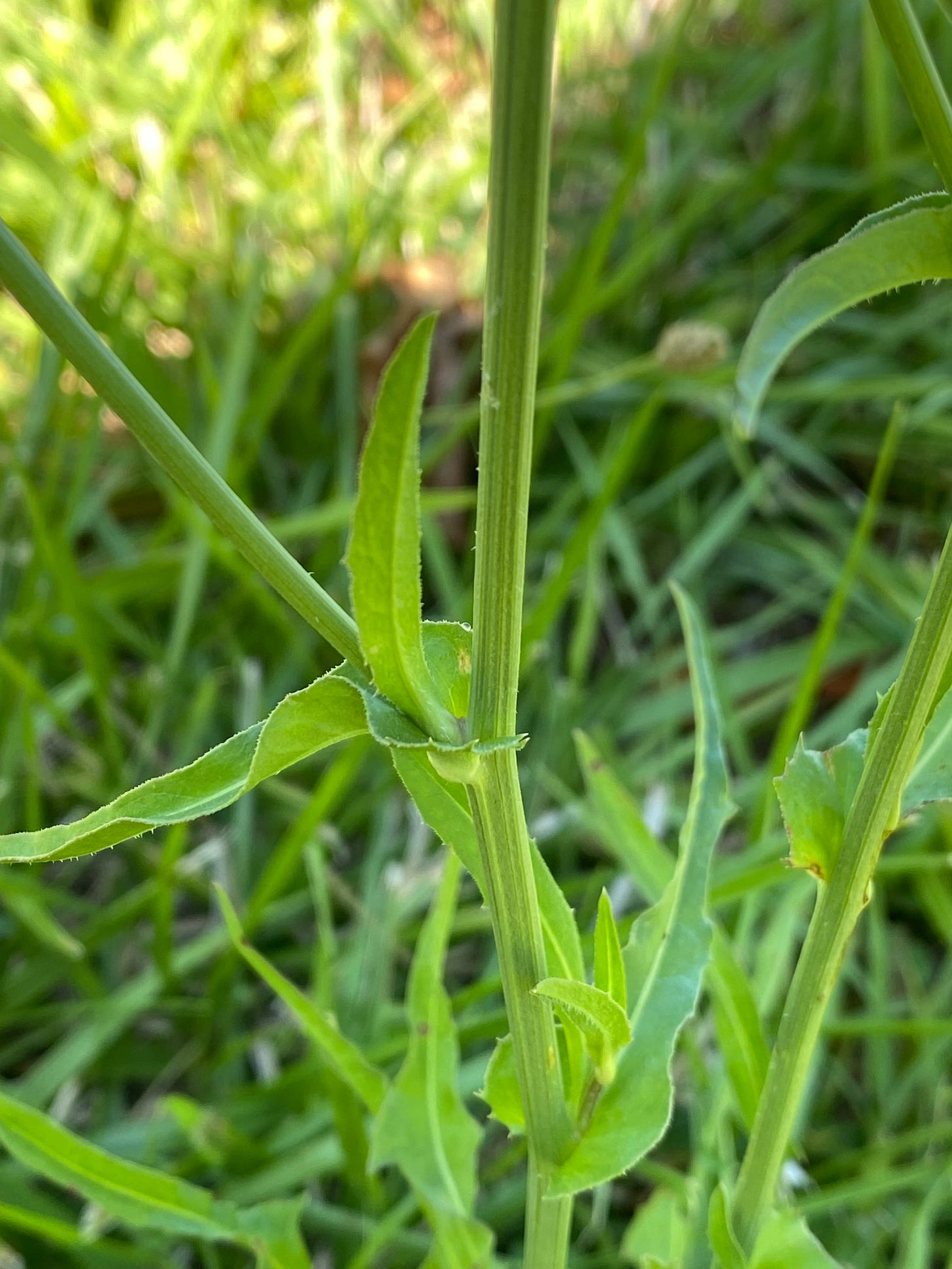
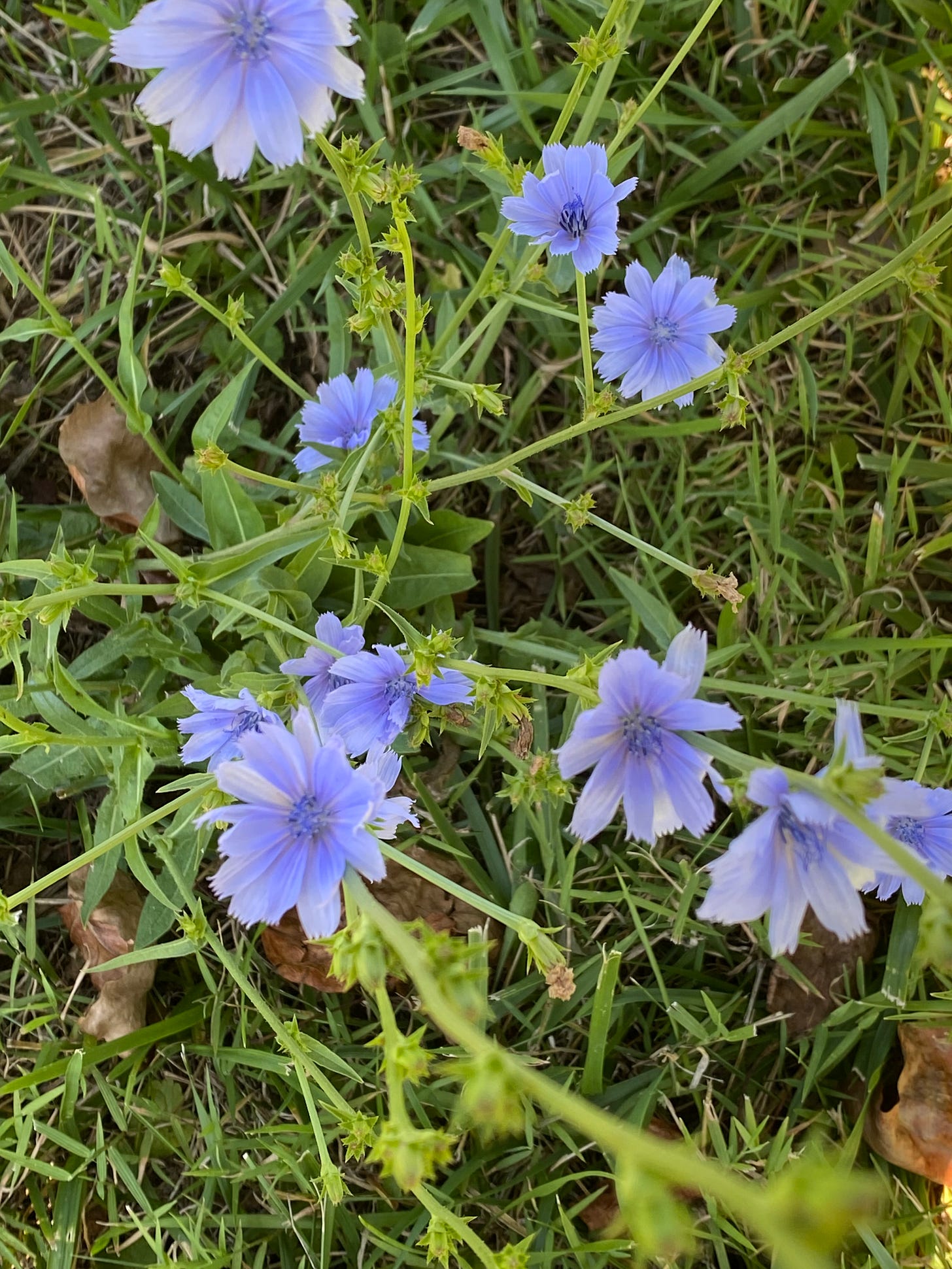

Weedom dear,
Found you just last week when on a coastal Maine island, where my garden hosts herbs both wild (e.g. plaintains, coltsfoot, yarrow, wintergreen, mugwort, comfrey et aliae) and cultivated (common culinary and others); now back home with various collections of culinary and medicinal in the gardens. I used my herbs medicinally (as well as in cooking, wine-making) 25 years ago; now retired, am back to re-establishing what had gone missing during the intervening 25 years. Just delighted to find you with your offering of phytochemical info! Had lately been reading PubMed papers on new investigations into medicinal usage of plants. Your writing is of such value that I would be happy to support financially. Never before made that offer on a first/second-time read!
Thanks weedom! Chicory is one of those wild herbs that occurs (introduced) in Oz but hasnt yet been found by the Bush Food forager. Ive been on holiday recently so I'll have some new material for your reading pleasure soon (so many Scaevolas!)
The only other plant that i noticed looks similar is false hawksbit (Crepis japonica etc). Its the only regular edible weed I recognise up here in tropical north Australia where I'm kicking my feet back in a Hilton on the Great Barrier Reef :) Theres not even Sonchus or Bidens up (down?!) here!
I may also have eaten too many sea almonds, but when they grow on every beach who can resist?